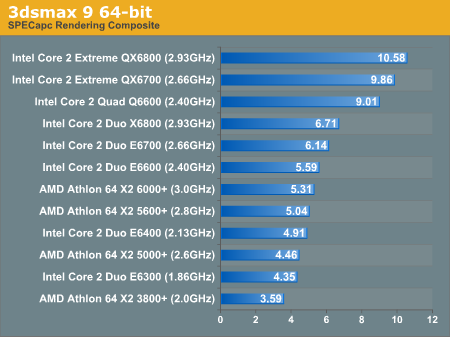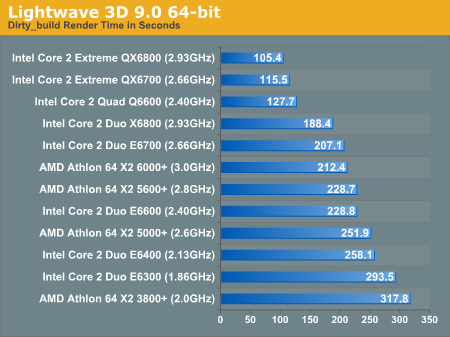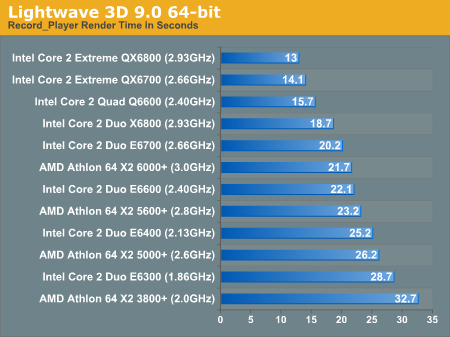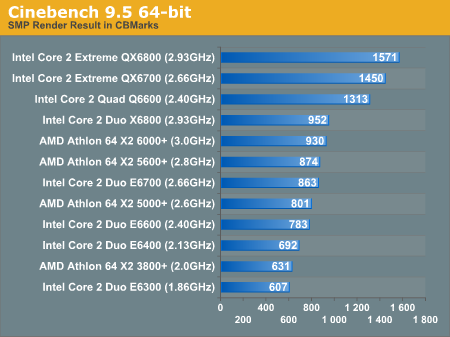Intel Core 2 Extreme QX6800: The Fastest Desktop CPU, now with more cores
by Anand Lal Shimpi on April 9, 2007 12:59 PM EST- Posted in
- CPUs
3D Rendering Performance
We've moved on to using 3dsmax 9, which allows us to run a 64-bit version of the program for our tests. The test scenario is still made up of the CPU rendering tests of the SPECapc 3dsmax benchmark. We report the rendering composite, which is simply the geometric mean of render times across seven benchmarks normalized to a set of reference scores. We ran 3dsmax 9 using its Direct3D driver given the poor state of OpenGL performance under Windows Vista.

Quad-core performance is even more pronounced in 3D rendering applications, with the QX6800 maintaining a 58% performance advantage over its dual core predecessor.
The price war continues with the 6000+ falling in between the E6600 and E6400 in performance, while the 5600+ outperforms both of its competitors.
Lightwave 3D 9.0 is available with 64-bit support, giving us another 64-bit 3D rendering test. We looked at performance under two scenes that ship with the program: Dirty_Building and Record_Player. We measured the time it took to render the scene in seconds, lower numbers are obviously better.


POV-Ray's ray tracing benchmark has been a popular CPU test for quite some time, and we turn to its 64-bit SMP beta to stress the CPUs here today:

Our final 3D benchmark is the 64-bit version of Cinebench 9.5, a fairly popular 3D rendering benchmark due to its ease of use and quick runtimes. We ran the multi-threaded CPU rendering test and reported the final score in CBmarks. Higher numbers are better:











34 Comments
View All Comments
TA152H - Monday, April 9, 2007 - link
I don't think you got my point. I'm not saying AMD will go out of business, just that their path would eventually lead them to it if nothing changed. For example, let's say they didn't have a new product out in a few months. Would they continue the policy they are on? I don't know the answer to that, but I think the upcoming new core has something to do with their current policy. I guess it would have to.I've never thought highly of Hector Ruiz, and I think even less of him now. I liked Jerry Sanders a lot, he was charismatic and visionary, and was the only one that could stand up to Intel. Many others tried, and they failed. And it was under his leadership that AMD passed Intel with the Athlon, and much of the current situation is from technology he was responsible for. He never backed down, and made excellent strategic moves like buying NexGen when the K5 ran into snags. I never worried whether AMD would survive under him. Ruiz, I just don't like him and I don't have as much faith in him. I still don't know why they are still on the K7+ core now, it's been way too long and something better should have come out years ago. They came out with a product good enough to beat the miserable P7, but they had to know Intel would come back fighting.
But, in the worst case, and I'm not saying this will happen, AMD will be bought by someone else rather than disappear into nothingness. IBM makes the most sense, particularly since they are out of the PC business and spend a lot on semiconductor manufacturing and developing even without AMD. In fact, I am a little surprised they aren't one company already. AMD by itself is a weakling that can only grow when their competitor missteps, and when their competitor is doing well, they lose money. And IBM/AMD combined company would give Intel fits, and be their roughly their equal.
At any rate, the industry will never allow Intel to be alone as an x86 maker. It's too lucrative a market, and Intel has produced some of the worst processors known to mankind. Uncontested, people might actually have to use them. It won't happen. Then again, we somehow let Microsoft dominate with their lousy products. So, who knows?
With regards to AMD knowing how to fight a price war, they have no chance in this one, outside of the Barcelona. Intel can make the chips cheaper, and they are much better processors. Plus, they still have a better reputation. Intel can take market share from AMD and make them like it right now. There just isn't anything AMD can do with their lousy K7+ and inferior manufacturing, plus high debt. And that's what's happening, Intel is winning back market share and AMD is selling their rubbish for peanuts to boot. But still, we have Hector the jackass telling all the world that AMD will not yield any market share gains, and instead will get to 30% this year. He's a buffoon, he is not in control of the situation, Intel is, and he's trying to use bravado to cover up the fact Intel will take what they want, it's just a matter of how much money they are willing to give up to do it. I really don't like this man.
Cyrix is dead now, VIA bought them and promptly killed their line off and went with the IDT Centaur line. I actually have one of their micro-ATX motherboards and processors running at 800 MHz. It's totally quiet, and it's elegant in it's own way, but for 800 MHz it's really slow. To me, it seems like it's roughly equivalent to a 500 MHz Katmai, and I'm not exaggerating. But, it uses less than 10 watts, so I guess that's to be expected.
yyrkoon - Tuesday, April 10, 2007 - link
This 'war' you speak of , is actually a battle, the war goes on indefinately, but yes, I got your point.As for who 'rules' AMD, I could care less, as long as they stay around, giving Intel a reason to make good products, and vice versa. I care more about things when AMD makes stupid judgement calls, as in switching socket types too often, and not supporting them for very long, but they are not the only ones guilty fo this, and to be honest, I am not sure if there really is much of a choice, when technology advances as fast as it is now.
AMD would never dissapear into nothingness, and they *could* go back to making IC's only, they probably just would not make as much money doing that alone.
Cyrix *has* been dead, for a long, long time now, at least in the desktop arena, which, in my opinion did not happen soon enough. I remember having a Cyrix P200, and playing quake2, and getting 7 FPS, popped the CPU out, droped in a P55 233MMX Intel CPU, bumped the FSP up to 75Mhz, and watched as it got over 60 FPS with the same settings . . . (I miss the good ole Super7 days, if only because the platform did not matter, you could use any CPU in it).
TA152H - Tuesday, April 10, 2007 - link
Actually, VIA bought Cyrix and actually released a few products based on their architecture, and then bought the Centaur line from IDT and stopped making the Cyrix based chips.Cyrix chips weren't always bad, at least on paper. I always had problems with them though, but in some ways they were way ahead of AMD. AMD was just a clone maker until they couldn't do it, whereas Cyrix made their own processors without copying Intel microcode. The chips you're talking about had miserable floating point performance, but their integer performance was excellent. They used that silly PR rating stuff where they were actually clocked lower than they were rated at, because of their superior IPC. Cyrix was also unique in the x86 world for saying that the decoupled architecture of the K5 and P6 was not the way to go, because you'd have too much trouble with OOP as you got to deeper pipelines. It would be interesting to see if they'd still be running x86 code natively today, or running some inelegant decoupled architecture like Intel and AMD are. Apparently, since AMD and Intel survived, it was the way to go.
AMD has been making x86 processors almost as long as Intel has. IBM used them extensively in their original PCs and so did Tandy. They were a licensed second source for Intel. Intel got a little greedy with the 386 and decided they didn't want AMD making them as well, although AMD eventually just reverse engineered it and did it anyway, creating a great legal battle. AMD 386s were excellent too, they ran at faster clock speeds, and used a lot less power. Unfortunately, their 486s sucked, they were unreliable. They seemed to have a lot of cache problems, and if you turned off the cache the processor ran OK, but with it, it wouldn't work. Mainly the DX2 80/40 had this, and I have no idea why.
You complain about the Cyrix chip, but did you ever try a K5? The floating point on that processor would make a man with a hairy back cry. That's just the way it was, Intel had ferocious floating point, and everyone else had lousy floating point. It was how they were able to compete. They didn't "waste" so many transistors on something that most people never used anyway, and that helped them a lot. Even the K6 with it's low latency, but non-pipelined floating point unit was way behind the Pentium. Only the Athlon changed that.
I don't miss Super 7 at all. You had a bunch of substandard companies backing that standard, and none of the chipsets were particularly stable. The VIA MVP3 was probably the best, the ALI was miserably bad. The MVP3 had terrible memory performance, even with motherboard cache memory. Even though it and the 440BX were both rated at 100 MHz, the memory performance on the 440BX was roughly 50% greater. The P55C didn't use Super 7 though, it used the regular Socket 7 chipsets, like the 430TX and 430HX, both of which were excellent. I still run my print server off a 430HX based Pentium 233 MMX. It does the job fine, and if I want to play any games from the mid to late 1990s, it's ideally suited for it.
KhoiFather - Monday, April 9, 2007 - link
This CPU is smoking hot!!!! I need to pick me up one of these when the price falls about 80%, yup yup!!!!